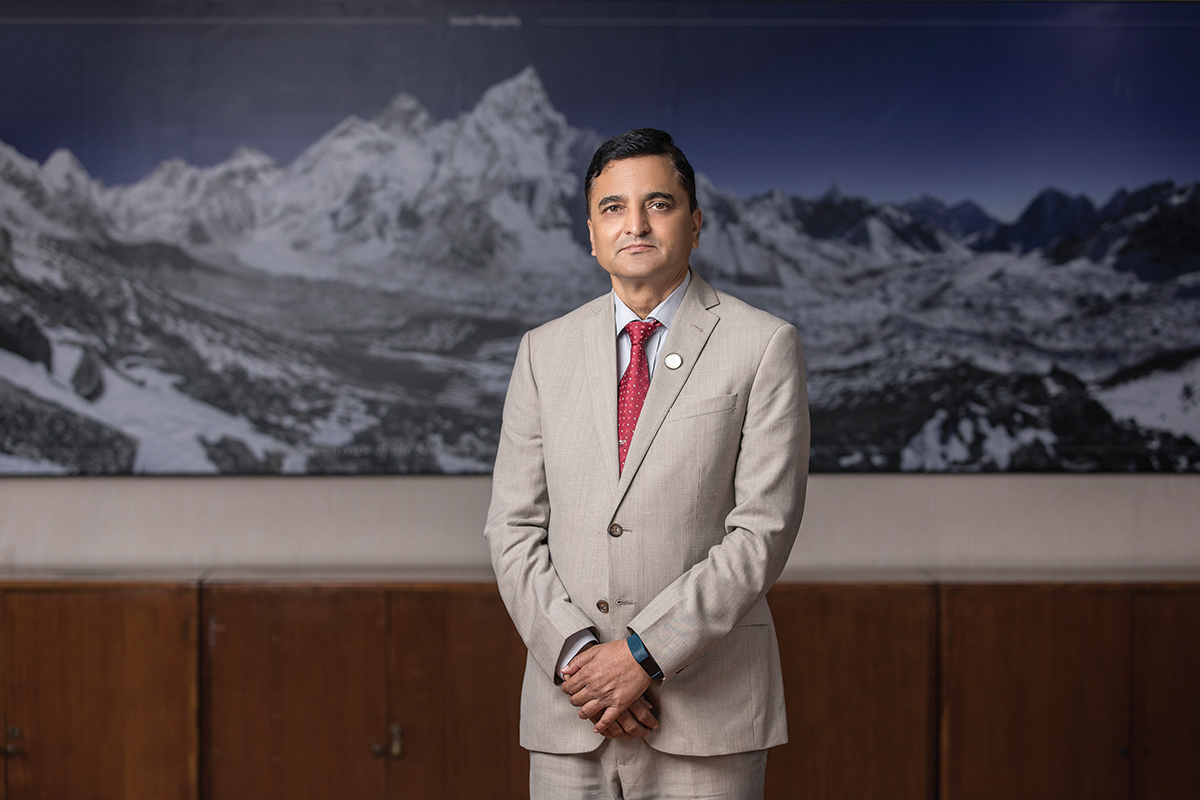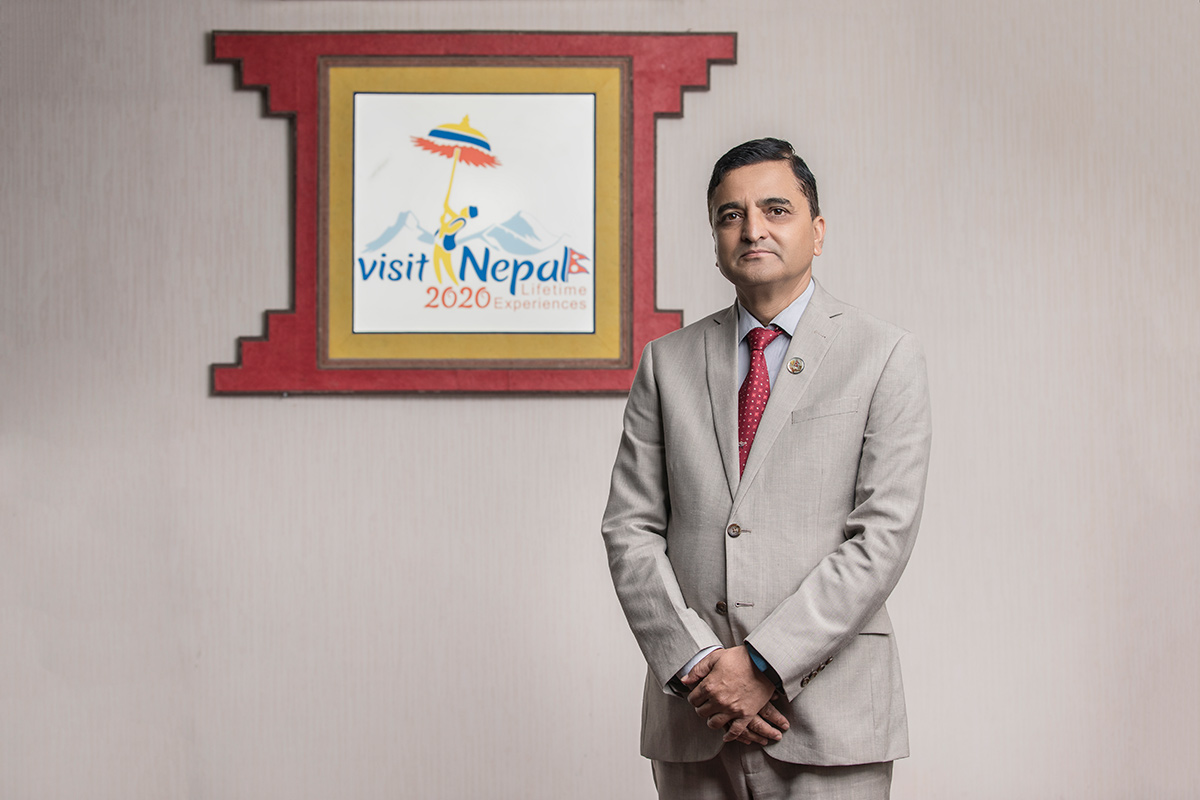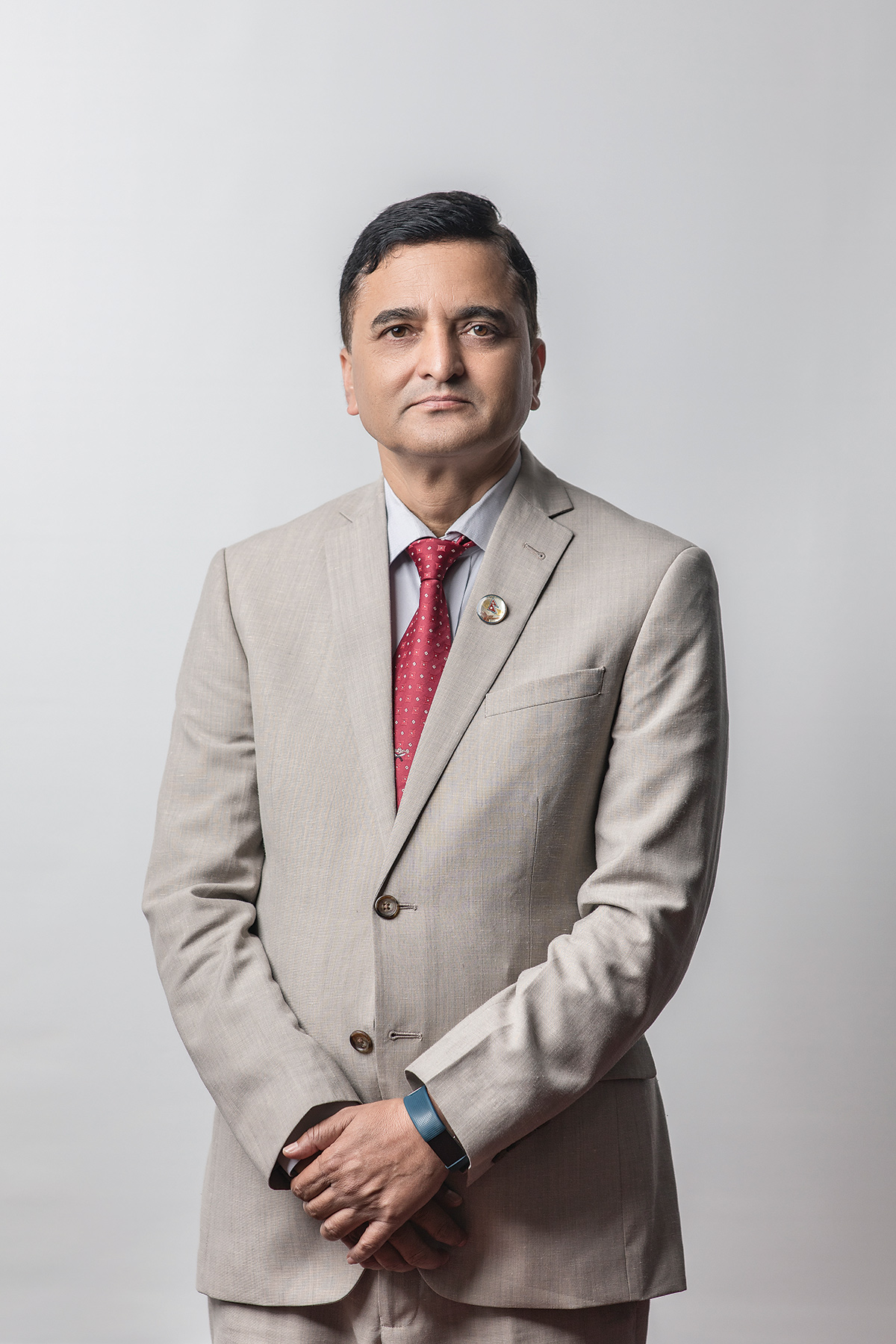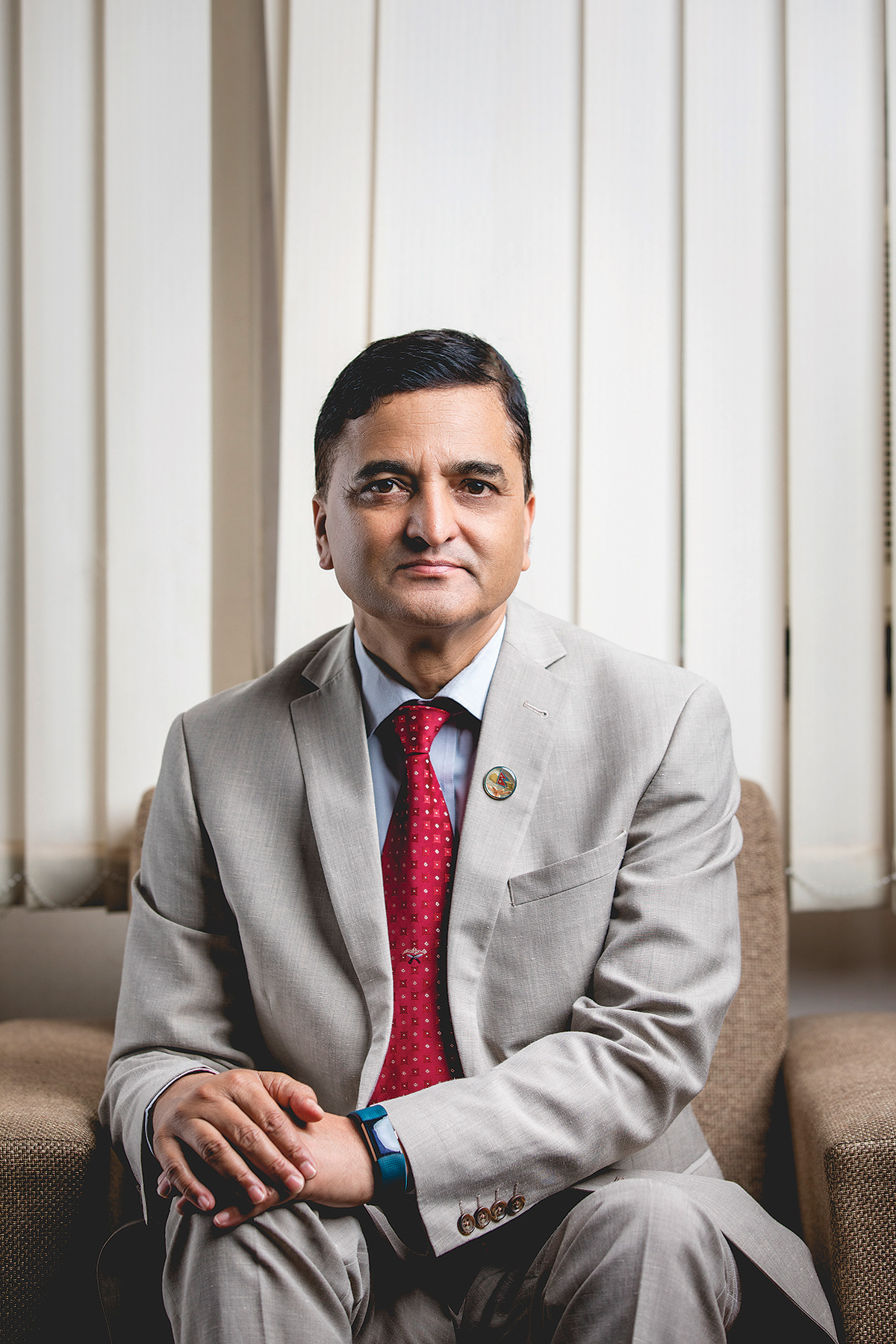
Yogesh Bhattarai, 53, from Taplejung came into national limelight when he was appointed Minister of Culture, Tourism and Civil Aviation on July 31, 2019. Earlier, he was managing the publicity department of the Nepal Communist Party.
A communist ideologue, Bhattarai actively participated in the student wing of UML, made a mark as a student leader and secured his position in the party’s central level.
Even though it is premature to assess his term as the head of the Ministry of Culture, Tourism and Civil Aviation, the Ministry does have predilection for garnering unwanted attention. Currently, it is mired in a number of controversial issues putting the Ministry and the new Minister under constant public scrutiny.
The Prime Minister was overseeing the Ministry till the appointment of Bhattarai which came after a gap of almost five months after the February 27 tragic helicopter crash that saw the demise of late Tourism Minister Rabindra Adhikari with six others.
This is Bhattarai’s first ministerial appointment and comes with the challenge of the Visit Nepal 2020 campaign. A lot rests on his leadership skills and abilities to turn around a sector that has been lying latent despite its immense potential. Stakeholders and the general public speculate whether the Minister can deliver. Time will tell.
Ujeena Rana of B360 interviewed Minister Bhattarai on key issues of the tourism industry and the way forward for his Ministry. Excerpts:

You were appointed Tourism Minister on July 31 with big expectations to fulfill? This was a Ministry without a minister for almost five months, what made you accept the proposal?
After the tragic demise of then Culture, Tourism and Civil Aviation Minister Rabindra Adhikari in an unfortunate helicopter crash on February 27, the Prime Minister himself oversaw the activities of the Ministry for almost five months. Due to the workload and busy schedule of the Prime Minister, the day-to-day activities in the ministry experienced some sort of inconveniences. Probably observing the same, the Prime Minister made the decision to appoint a minister for a ministry that was devoid of a top leader.
On July 31 at around 2 pm, I received a call from the Office of the Prime Minister summoning me to meet him. I reached there at around 3 pm. I had to speak at the Parliament on the same day. In the meeting, the Prime Minister shared his concerns over the absence of a leader at the Culture, Tourism and Civil Aviation Ministry and that the Ministry has a number of ongoing projects which required supervision and therefore, I was to take charge of the Ministry. I had not expected such a proposition from him when I went to his office for the meeting. I thought the objective of the meeting was party-related. I was not prepared for the proposition and therefore for a few seconds I did not know how to react. After I had collected myself, I posed a few questions to him about how to go about with the Ministry’s works. With full confidence, the Prime Minister offered me the portfolio and I accepted it. And around 4:30 pm, I was sworn in by the President.
Where did the late Tourism Minister Rabindra Adhikary leave and where did you pick up the responsibilities of the Ministry? What are the major changes in plans you are introducing after taking up this responsibility?
Late Rabindra Adhikary was an experienced leader and politician. The public had elected him thrice for the Parliament. He had ample experience pertaining to infrastructure development. And even as a Minister he worked for a little more than a year. In that regard, he had initiated a number of projects.
Presently, this Ministry has garnered interest of the international community and that of the entire country. There is a list of events that the Ministry started in the past which I need to give a proper conclusion to. And then there are other projects which have been created courtesy of the new circumstances, and I need to take those projects forward. Coordination between the old and the new projects need to be put in place. The Ministry needs to function in accordance with the policy and programs presented in the Parliament, the budget, Nepal Communist Party’s manifesto and that of other parties, and the advice from experts and stakeholders from the culture, tourism and civil aviation sectors. I have prepared a one-year action plan with 141 points which has already been made public.
The action plan talks about making Nepal Airlines Corporation (NAC) a public company. When will that happen and what is the rationale behind it?
Nepal Airlines is a matter of the country’s pride. To save its face and to reinstate it is the shared business of the entire nation. After I joined the Ministry, I have sat down with the management of NAC several times. And after listening to them, I came to a conclusion that the organisation needs to undergo massive transformation.
I proposed to form an expert group. Decisions will be made as per the recommendations they provide. For that I have already formed a task force which will submit their report to me soon.
Now, about making NAC a company, it was a decision the government had made a long time back. I am merely readying the groundwork for the same. But this will take place in the participation of the government, investors, private sector. We will make a company which the entire nation can take ownership of. We will increase its capital capacity. Its assets will also be increased. We will work towards improving the commercial ability of NAC. Noticeable improvement on the management side will be introduced. In the course of a few years, all these improvements will be in place to take NAC on a growth path.
When is this likely to happen?
About the deadline as to when NAC will be made into a public company, first let the report from the task force come. We will then discuss the same in the Ministry and with the Council of Ministers because we require their decision as well. Many rules and procedures need to be amended. To fulfill all these processes might need at least three months.
*(Update: The task force submitted its report to Minister Bhattarai on September 19 which suggests converting the state-run company to a public limited company. The report contains 13 immediate actions and 12 long-term measures to bail out NAC which is under a grim financial crisis. As per the report, NAC’s loss stands at Rs 5.21 billion, while its debt is Rs 40 billion. Its total assets come around Rs 3.60 billion. Additionally, it has suggested the government to find a strategic partner for improving the management of the national carrier.)

Environmentalists are staging rallies against government plans to cut down trees to make room for the Nijgadh airport? Has the Ministry evaluated the result of this massive deforestation which is not just about cutting down trees but impacts wildlife, communities and the ecosystem? Is the Nijgadh Airport actually needed? Despite heavy criticisms from all fronts, why are you still advocating for Nijgadh Airport?
Firstly, a couple of our international airports are in the process of construction: Gautam Buddha and Pokhara airports. They will help take care of a few of our current necessities. However, the kind of heavy lifting that TIA is doing presently cannot be handled by Gautam Buddha and Pokhara Airports only. Also because of its proximity with the capital, Nijgadh is the uncontested option. It does not have any alternative. We have spent almost 24 years discussing the feasibility of Nijgadh. How long should a nation spend its time discussing a singular project? Now, if we revisit the practical aspects of Nijgadh, we will only be squandering time. Nijgadh is not a political decision; the decision was made after experts submitted their report. Eight or nine places were studied and out of which Nijgadh proved to be the most appropriate location for an international airport. It was on the basis of the report submitted by experts that the government made its decision. On that basis, a political decision was made.
There won’t be any further discussion over Nijgadh. An airport will be made there for sure.
We are undoubtedly sensitive about the environment and other concerns. Nepal government is not building an airport in Nijgadh with the purpose of deforestation or the deterioration of the environment. This is something I have reiterated since joining office, I am not advocating for Nijgadh airport with the sole objective to do away with the trees; I am only advocating for Nijgadh for the airport.
Since the country practices the federal government system, there are multiple layers of governing bodies: federal, provincial, local. For completion of a national pride project, it is necessary to form coordination and collaboration among all three layers of the government. Very soon we will sit down with the chief minister, governor and the other government agencies of Province No. 2.
You have included removal of Nepal from the blacklist of European Union as one of the 141 plans in your Ministry’s annual action plan. The effort is long ongoing, what is the progress on it?
I don’t think there is any reason left for European Union to continue to put us in its blacklist. We have been addressing their concerns. Our civil aviation department has undergone considerable facelift compared to the past. And regarding safety and security concerns, we have made tremendous improvements.
On the civil aviation matter, we are still learning. That’s why we might encounter a few errors. Compared to other nations, we might have some weaknesses. That we accept. But we have not made mistakes big enough to put us in the blacklist. We have received more than the average number in the safety audit of International Civil Aviation Organisation (ICAO). Let’s say the average number is 60%, we have received 66.5%, and our aim is to improve the performance in the next audit scheduled for ICAO and we are working on the same.
There were some concerns raised by ICAO regarding CAAN—to segregate its functions under service provider and regulatory body. Accordingly, we have drafted acts, and suggestions are being collected from multiple ministries. We will table it in the next Parliament session.
A few members from the management committee of CAAN have also been voicing about the organisation’s structural change. We are positive about it and are working towards the same. Moreover, the service, safety and security aspects of our airports have been upgraded. We are adding new technologies.
We have a great legacy and a long relationship with Europe. Nepal had its first embassy in Britain. Our history, legacy, our unfettering attempts towards improvements, our series of discussions with the members of the EU, and even after my joining the office, I have met with the ambassadors of almost all the EU nations, I have talked to them, have discussed with their delegations; all these have provided enough grounds for me to say with confidence and hope that we will soon be out of the ban list.
We have mobilised our diplomatic centers in Europe to work towards the same objective. Our government and non-government agencies have formed mechanisms to work jointly in this effort.
What are a few of the major takeaways from the 141-point action plan of your Ministry?
Major works from the 141-point action plan are already mentioned in the 15th five year plan. It has identified targets in the field of tourism. It also mentions that in five years, tourism sector’s contribution in the country’s GDP will be 10%. Our objective is to meet that target. Likewise, we present our annual operation plan before the parliament. That also acts as our guide. Besides, the election manifesto of the political party that I belong to and that of other parties are our reference for work. To incorporate all those plans, we have designed 15-day, 30-day, 6-month action plans which make up the 141-point action plan.
For the same, we are in the process of reforming some policies. Acts and laws of the past are inadequate for the smooth functioning in today’s time. We are reviewing these. For some, we are going into the umbrella act like whether to build Tourism and Mountaineering University, or a research center. All these need to be followed through legal processes. We will work towards formulating these laws. We will go into the restructuring of the airport. Besides, new and ongoing airport projects need to be completed within the deadline. Gautam Buddha International Airport needs to be completed by this December whereas Pokhara International Airport is scheduled for completion by December 2020. There are matters regarding the upgradation of the domestic airports, preservation and rebuilding of our heritage sites, all these are incorporated in the 141-point action plan. Our Ministry will conduct regular monitoring and if and when needed, it will also provide necessary instructions. I am confident that within one year we will be able to witness substantial changes.
What are your thoughts on the Nepal Tourism Board? Most industry stakeholders are unhappy with its performance. Is the NTB under review for change in work systems and goal setting?
We are in the process of discussions. Nepal Tourism Board functions in a sort of public-private partnership (PPP) model. There are also members from the private sector fraternity on the board. So, it is not that the private sector has zero participation in its functions, but they are not satisfied with just that. We respect their interest. A kind of discourse is surfacing that even the NTB, with view of its nature of work, needs to be divided into two parts: promotional activities and infrastructure development. Presently, both of these works are conducted by NTB. Keeping NTB primarily for promotional activities, we may possibly formulate a separate board or corporation for infrastructure development. That is what we are meditating on at present. We have not reached any conclusion yet. But we will move forward in consultation with all concerned stakeholders. Our commitment is to make NTB more effective and efficient.
Could you comment on your Ministry’s newly introduced rule ordering citizens to stand up for the national anthem in cinema halls before screening of movies and the national anthem being played at Pashupatinath before the Arati? Why is this important?
This is just an exercise. Let’s see how people will comment on it. And we will take further steps on it only then.
Can we then understand that the Ministry is ready to amend the rule if needed?
The rule has just been implemented. It has started a discussion, we know. We have forwarded logic as to why the national anthem should be played. Before the onset of any pious work, you pay respect to the country. During festivities, celebration and joyous occasions, the national anthem is played. Many people want to make it a part of an unnecessary debate and it is in their vested interest. I don’t want to debate with them now. Let it be implemented and let us collect public reaction on it. According to the same, we will act. The government is always flexible.
What is your vision for the airport and its management?
First of all, TIA is our only international airport at the moment. TIA provides services to around 70 lakh international passengers annually. TIA’s area and its ability to provide service is not directly proportional to the number of guests it serves. However, currently, we don’t have an alternative. We are somehow being able to manage the airport -with timely expansion of the airport and increasing and improving its services.
Once the operation of Gautam Buddha and Pokhara International Airport commence, the load on TIA will be lighter to some extent. But without Nijgadh Airport, the perils of TIA won’t come to an end. If you look at the annual influx of foreigners in our country, there is an increment of almost 12%. Keeping that in perspective, TIA alone cannot provide the required services. That we accept. But the basic services that an airport should provide like cleanliness and effective immigration service, we are in the process of improving on those fronts. In the next 2-3 months, TIA will undergo substantial upgradation.

Visit Nepal 2020 came in an unstructured way. Usually countries work and plan and strategise for a year or two in advance. What are the real expectations from this campaign?
Of course, we did not have ample preparation time. For some time in between, the Ministry was without a minister. That’s why, many tasks which should have been conducted at a certain pace, could not happen. But we should not be distressed about the situation because we have formed Visit Nepal 2020 Secretariat, have delegated responsibilities to people, we have allocated budgets which means that the concerned bodies can function actively. We have given them Terms of Reference (TOR) and we are also monitoring their works.
But the fact is that we have very less time to welcome guests under the VN 2020 campaign. To dedicate the remaining days for the full-fledged campaigning of the project, we have planned to mobilise our diplomatic agencies stationed in foreign countries. We need to identify core destination countries so that we can center our campaign in those countries. Coordination among the concerned bodies within our country should be in place. All the private and government organisations need to be mobilised in tandem with one another. This is what we are working towards.
After I joined the office, we had a meeting on the VNY campaign and we have finalised a to-do list and we will work according to the same. We will try our best to entertain two million tourists. If we look at it, it is not a big number, because in 2018, reports show that we had 1.2 million tourists. This is not an impossible target.
We are improving on multiple infrastructure areas like the increment in the number of airports, likewise, the number of flights of the airlines has been increased every day. We will coordinate with NRNs spread across the world. That’s why I don’t think we have set a huge target before us. Having said that, we cannot under-prepare or sit idle.
You said “There is a need to explore and research new products and experiences to offer to our guests, otherwise repeat visitors - which is a trend in Nepal - will be bored by the same monotonous offerings and the country will fall victim to tourism stereotypes.” What new products and experiences have been identified and will they be part of VN 2020?
What I meant was that let’s open some Himalayas, and some places which are prohibited, let’s redefine the restricted zones and let’s promote new destinations aggressively. For this, we have asked the Visit Nepal Secretariat to submit proposals, they have assured that the Ministry will receive those proposals in 15 days. Some of the proposals put forth will be decided by the council of ministers, while some I need to decide on behalf of the Ministry.



-1712728897.jpg)
-1709873108.jpg)
-1706600212.jpg)